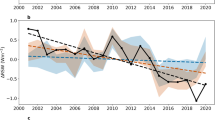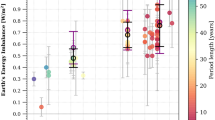Abstract
The Earth’s energy budget for the past four decades can now be closed1, and it supports anthropogenic greenhouse forcing as the cause for climate warming. However, closure depends on invoking an unrealistically large increase in aerosol cooling2 during the so-called global warming hiatus since the late 1990s (refs 3,4) that was due partly to tropical Pacific Ocean cooling5,6,7. The difficulty with this closure lies in the assumption that the same climate feedback applies to both anthropogenic warming and natural cooling. Here we analyse climate model simulations with and without anthropogenic increases in greenhouse gas concentrations, and show that top-of-the-atmosphere radiation and global mean surface temperature are much less tightly coupled for natural decadal variability than for the greenhouse-gas-induced response, implying distinct climate feedback between anthropogenic warming and natural variability. In addition, we identify a phase difference between top-of-the-atmosphere radiation and global mean surface temperature such that ocean heat uptake tends to slow down during the surface warming hiatus. This result deviates from existing energy theory but we find that it is broadly consistent with observations. Our study highlights the importance of developing metrics that distinguish anthropogenic change from natural variations to attribute climate variability and to estimate climate sensitivity from observations.
This is a preview of subscription content, access via your institution
Access options
Subscribe to this journal
Receive 12 print issues and online access
$259.00 per year
only $21.58 per issue
Buy this article
- Purchase on Springer Link
- Instant access to full article PDF
Prices may be subject to local taxes which are calculated during checkout




Similar content being viewed by others
References
IPCC Climate Change 2013: The Physical Science Basis (eds Stocker, T. F. et al.) 33–115 (Cambridge Univ. Press, 2013).
Murphy, D. M. Little net clear-sky radiative forcing from recent regional redistribution of aerosols. Nature Geosci. 6, 258–262 (2013).
Murphy, D. M. et al. An observationally based energy balance for the Earth since 1950. J. Geophys. Res. 114, D17107 (2009).
Church, J. A. et al. Revisiting the Earth’s sea-level and energy budgets from 1961 to 2008. Geophys. Res. Lett. 38, L18601 (2011).
Meehl, G. A., Arblaster, J. M., Fasullo, J. T., Hu, A. X. & Trenberth, K. E. Model-based evidence of deep-ocean heat uptake during surface-temperature hiatus periods. Nature Clim. Change 1, 360–364 (2011).
Kosaka, Y. & Xie, S.-P. Recent global-warming hiatus tied to equatorial Pacific surface cooling. Nature 501, 403–407 (2013).
England, M. H. et al. Recent intensification of wind-driven circulation in the Pacific and the ongoing warming hiatus. Nature Clim. Change 4, 222–227 (2014).
Gregory, J. M. et al. A new method for diagnosing radiative forcing and climate sensitivity. Geophys. Res. Lett. 31, L03205 (2004).
Watanabe, M. et al. Contribution of natural decadal variability to global warming acceleration and hiatus. Nature Clim. Change 4, 893–897 (2014).
Schmidt, G. A., Shindell, D. T. & Tsigaridis, K. Reconciling warming trends. Nature Geosci. 7, 158–160 (2014).
Santer, B. D. et al. Volcanic contribution to decadal changes in tropospheric temperature. Nature Geosci. 7, 185–189 (2014).
Levitus, S. et al. World ocean heat content and thermosteric sea level change (0–2000 m), 1955–2010. Geophys. Res. Lett. 39, L10603 (2012).
Trenberth, K. E., Fasullo, J. T. & Balmaseda, M. A. Earth’s energy imbalance. J. Clim. 27, 3129–3144 (2014).
Loeb, N. G. et al. Observed changes in top-of-the-atmosphere radiation and upper-ocean heating consistent within uncertainty. Nature Geosci. 5, 110–113 (2012).
Liu, Z. Dynamics of interdecadal climate variability: A historical perspective. J. Clim. 25, 1963–1995 (2012).
Zhang, Y., Wallace, J. M. & Battisti, D. S. ENSO-like interdecadal variability: 1900–93. J. Clim. 10, 1004–1020 (1997).
Power, S., Casey, T., Folland, C., Colman, A. V. & Mehta, V. Inter-decadal modulation of the impact of ENSO on Australia. Clim. Dynam. 15, 319–324 (1999).
Chen, X. & Tung, K.-K. Varying planetary heat sink led to global-warming slowdown and acceleration. Science 345, 897–903 (2014).
Clement, A. C., DiNezio, P. & Deser, C. Rethinking the ocean’s role in the Southern Oscillation. J. Clim. 24, 4056–4072 (2011).
Okumura, Y. M. Origins of tropical Pacific decadal variability: Role of stochastic atmospheric forcing from the South Pacific. J. Clim. 26, 9791–9796 (2013).
Smith, D. M. et al. Earth’s energy imbalance since 1960 in observations and CMIP5 models. Geophys. Res. Lett. 42, 1205–1213 (2015).
Allan, R. P. et al. Changes in global net radiative imbalance 1985–2012. Geophys. Res. Lett. 41, 5588–5597 (2014).
Cheng, L. & Zhu, J. Artifacts in variations of ocean heat content induced by the observation system changes. Geophys. Res. Lett. 41, 7276–7283 (2014).
Brown, P. T., Li, W., Li, L. & Ming, Y. Top-of-atmosphere radiative contribution to unforced decadal global temperature variability in climate models. Geophys. Res. Lett. 41, 5175–5183 (2014).
Palmer, M. D. & McNeall, D. J. Internal variability of Earth’s energy budget simulated by CMIP5 climate models. Environ. Res. Lett. 9, 034016 (2014).
Dalton, M. D. & Shell, K. M. Comparison of short-term and long-term radiative feedbacks and variability in twentieth-century global climate model simulations. J. Clim. 26, 10051–10070 (2013).
Katsman, C. A. & van Oldenborgh, G. J. Tracing the upper ocean’s “missing heat”. Geophys. Res. Lett. 38, L14610 (2011).
Roemmich, D. et al. Unabated planetary warming and its ocean structure since 2006. Nature Clim. Change 5, 240–245 (2015).
Hansen, J., Sato, M., Kharecha, P. & von Schuckmann, K. Earth’s energy imbalance and implications. Atmos. Chem. Phys. 11, 13421–13449 (2011).
Ishii, M. & Kimoto, M. Reevaluation of historical ocean heat content variations with time-varying XBT and MBT depth bias corrections. J. Oceanogr. 65, 287–299 (2009).
Lyman, J. M. et al. Robust warming of the global upper ocean. Nature 465, 334–337 (2010).
Palmer, M. D., Haines, K., Tett, S. F. B. & Ansell, T. J. Isolating the signal of ocean global warming. Geophys. Res. Lett. 34, L23610 (2007).
Willis, J. K., Roemmich, D. & Cornuelle, B. Interannual variability in upper ocean heat content, temperature, and thermosteric expansion on global scales. J. Geophys. Res. 109, C12036 (2004).
Gouretski, V. & Reseghetti, F. On depth and temperature biases in bathythermograph data: Development of a new correction scheme based on analysis of a global ocean database. Deep-Sea Res. I 57, 812–833 (2010).
Domingues, C. M. et al. Improved estimates of upper-ocean warming and multi-decadal sea-level rise. Nature 453, 1090–1093 (2008).
Forster, P. M. et al. Evaluating adjusted forcing and model spread for historical and future scenarios in the CMIP5 generation of climate models. J. Geophys. Res. 118, 1139–1150 (2013).
Gent, P. R. et al. The community climate system model version 4. J. Clim. 24, 4973–4991 (2011).
Spencer, R. W. & Braswell, W. D. On the misdiagnosis of surface temperature feedbacks from variations in Earth’s radiant energy balance. Remote Sensing 3, 1603–1613 (2011).
Dee, D. P. et al. The ERA-Interim reanalysis: Configuration and performance of the data assimilation system. Q. J. R. Meteorol. Soc. 137, 553–597 (2011).
Morice, C. P., Kennedy, J. J., Rayner, N. A. & Jones, P. D. Quantifying uncertainties in global and regional temperature change using an ensemble of observational estimates: The HadCRUT4 data set. J. Geophys. Res. 117, D08101 (2012).
Acknowledgements
S.-P.X. and Y.M.O. are supported by the US National Science Foundation and National Oceanic and Atmospheric Administration. Y.K. is supported by the Japanese Ministry of Education, Culture, Sports, Science and Technology through Grant-in-Aid for Young Scientists 15H05466 and by the Japanese Ministry of Environment through the Environment Research and Technology Development Fund 2-1503. The CAM4-OML output is provided by R. Thomas and C. Deser of the National Center for Atmospheric Research.
Author information
Authors and Affiliations
Contributions
S.-P.X. conceived the study and wrote the paper. Y.K. and Y.M.O. contributed to the development of the idea and performed the analysis. All the authors discussed the results and commented on the manuscript.
Corresponding author
Ethics declarations
Competing interests
The authors declare no competing financial interests.
Supplementary information
Supplementary Information
Supplementary Information (PDF 1026 kb)
Rights and permissions
About this article
Cite this article
Xie, SP., Kosaka, Y. & Okumura, Y. Distinct energy budgets for anthropogenic and natural changes during global warming hiatus. Nature Geosci 9, 29–33 (2016). https://doi.org/10.1038/ngeo2581
Received:
Accepted:
Published:
Issue Date:
DOI: https://doi.org/10.1038/ngeo2581
This article is cited by
-
Sea surface warming patterns drive hydrological sensitivity uncertainties
Nature Climate Change (2023)
-
A comprehensive review on methane’s dual role: effects in climate change and potential as a carbon–neutral energy source
Environmental Science and Pollution Research (2023)
-
Roles of climate feedback and ocean vertical mixing in modulating global warming rate
Climate Dynamics (2023)
-
On the Pacific Decadal Oscillation Simulations in CMIP6 Models: A New Test-Bed from Climate Network Analysis
Asia-Pacific Journal of Atmospheric Sciences (2023)
-
Greater committed warming after accounting for the pattern effect
Nature Climate Change (2021)



